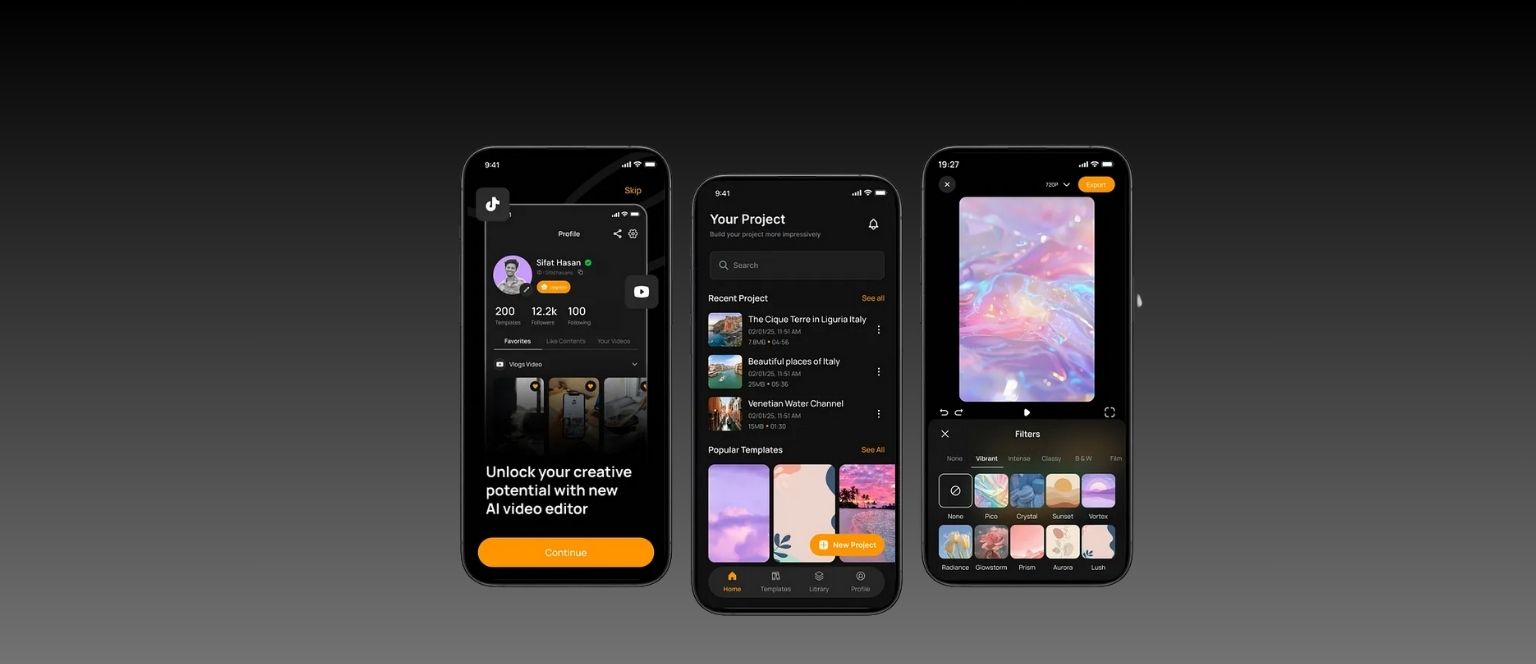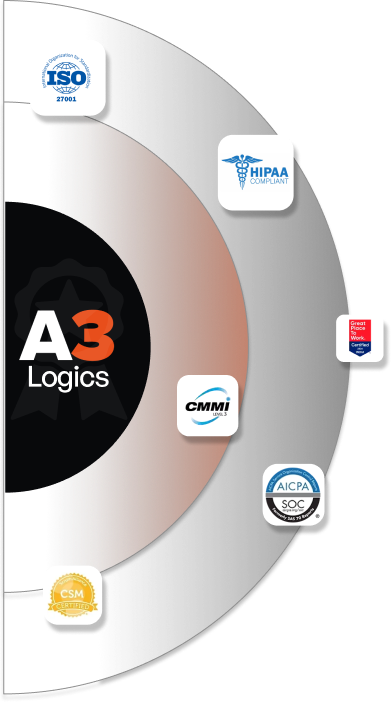What is Data Ingestion: Imagine you are trying to cook a delicious meal without having any ingredients in your kitchen. Sounds impossible, right? This would help us to understand the concept of working with data but without data ingestion. Today, businesses are running on data, encompassing all sorts of activities, customer input, sales numbers, and anything that is trending on social media. All these companies need new and accurate data to make intelligent choices.
However, before data gets to be analyzed or utilized, it has to be ingested, and during ingestion, it is collected and cleaned and finally placed into its systems.
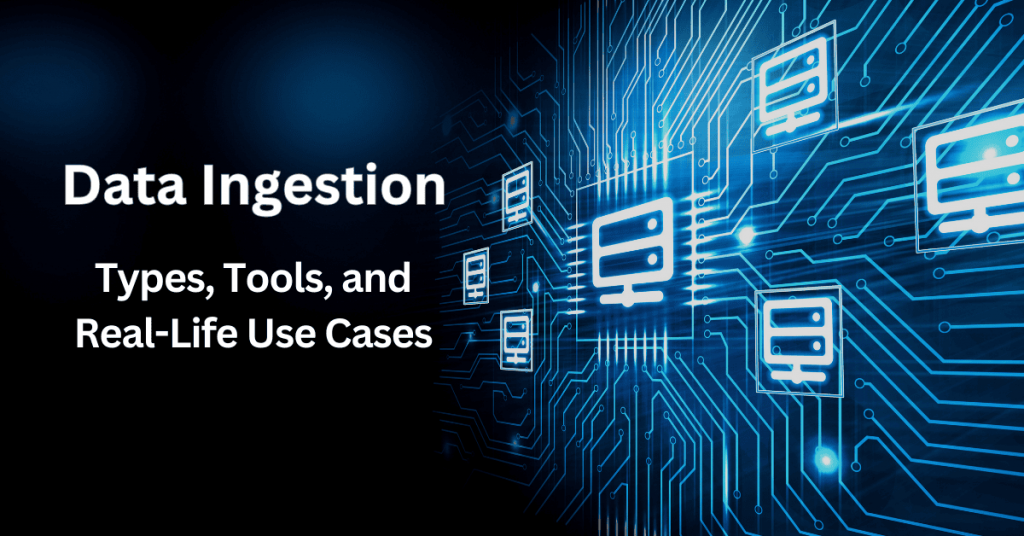
Data ingestion is like the front door of a data system, which is from where the information enters, whether from apps, websites, sensors, or databases. More companies are becoming data-driven, and data collection is increasing at breakneck speed, making robust data ingestion even more critical. It is the first step that feeds everything from real-time dashboards to AI predictions, without which the rest of the system just cannot run appropriately.
In this blog, you will discover everything about data ingestion like What is data ingestion? The types of data ingestion, why it is important, real time use cases, top data ingestion tools, and many more.
Quick Takeaways on Data Ingestion
- Data ingestion is the preliminary process that allows raw data to be used; it brings together and extracts data from several sources to a collective location.
- Moreover, information at the right time, quick decision-making, and remaining at the peak of the competition in the world of data is important.
- The available ingests are set, real-time (streaming), and hybrid.
- Instruments such as Apache Kafka, Talend, and Fivetran are used as implements for streamlining and simplifying the process.
- The selection of an appropriate tool relies heavily on compatibility, scalability, budgeting, user-friendliness, and support requirements.
- By means of structured, semi-structured, and unstructured data, data ingestion transforms itself to cater to various industries, which is becoming not only a highly trending subject but also a flexible one.
- Businesses can become data people by choosing the right data pathway and partner, which, in turn, can become the basis of growth and success.
Table of Contents
What is Data Ingestion?
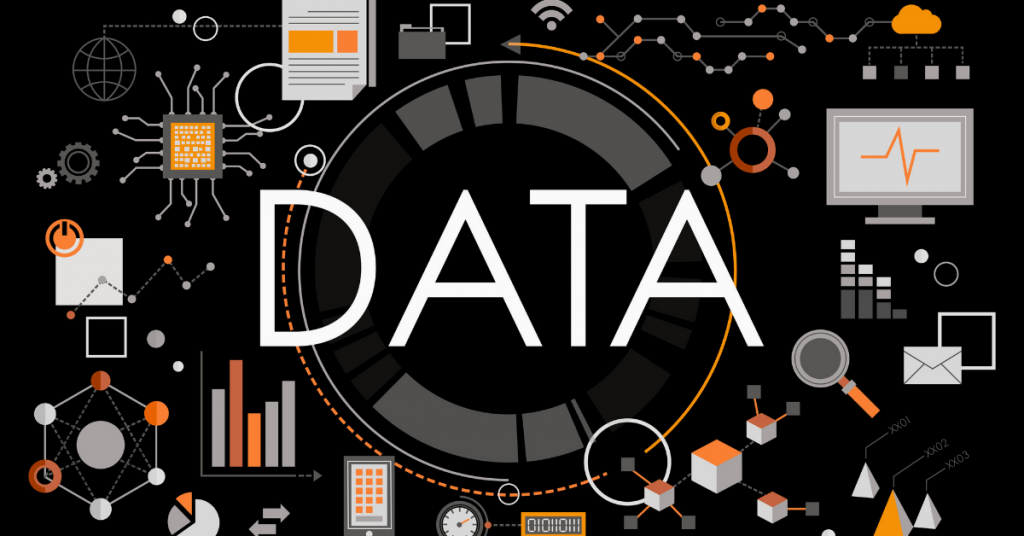
Data ingestion represents the process of gathering and taking information from a variety of sources to a single place, which is most commonly a central system such as a data warehouse, a database, or a data lake where it can be used for analysis or other purposes. It is like picking up groceries from different shops on the way home before you start cooking.
Data ingestion is the transformation or movement of raw data from its source of origin (like apps, websites, devices, or cloud services) to the place where it can be saved and used. This can be done in real-time, minimizing the time between data generation and the time it reaches the storage area (Hence, Data Ingestion occurs at the same time the data is being generated) or in batches (data is ingested according to some kind of a schedule; for example, every day).
How It Fits into the Broader Data Pipeline
Data ingestion is the first stage in the expedition of data, and it is called the data pipeline. Data ingestion flows seamlessly into:
- Data Ingestion: Cleaning, purification, and formatting the imported data (which sometimes may require transformations) makes it ready for the application of the intended purpose.
- Data Processing: The raw data is subsequently cleaned, formatted, and sometimes transformed into a presentable form.
- Data Storage: The processed data is then stored in databases or data lakes.
- Data Analysis & Visualization: Finally, the data is used by dashboards or machine-learning models to generate insights or make predictions.
None of the other steps can happen without data ingestion. Owing to the existence of a trustworthy and established data ingestion system, the data would be accurate, time-sensitive, and available for further actions concerning the decision-making process.
Why is Data Ingestion Important?
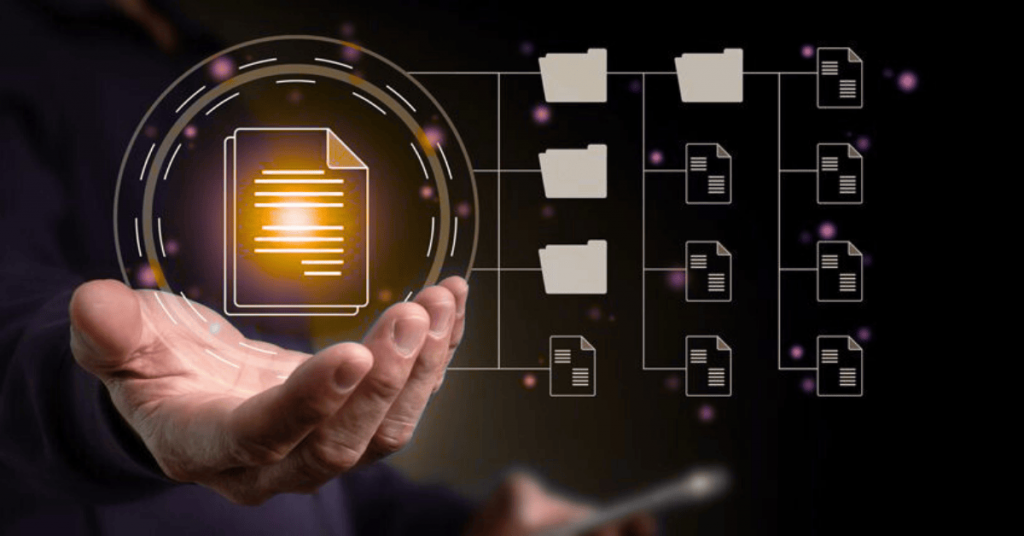
In a world where data is key to every decision, data ingestion makes this data useful. It is certainly not just collecting information. It should be brought in securely and fast, in a manner that will really help a business grow and succeed. Let’s break down the importance of data ingestion:
1. Real-Time Insights
Through data ingestion, companies can analyze data as it is created. This allows them to make quick decisions about trends, resolve issues, or respond to customer behaviour. Imagine it as having a live feed of what’s happening so you can act with proximity rather than hindsight.
2. Improved Data Quality
The data collected is well-cleaned and organized as it comes into existence. Association removes errors, duplicates, and missing values. This makes the data more reliable. The more reliable data, the more accurate analyses can be made, leading to improved business decisions.
3. Staying Competitive
When a company can provide accurate data for faster processing, it can be a step ahead in the long run. Be it marketing, customer service, or even operations, good and effective data ingestion allows teams to quickly make worthy moves before their competitors.
4. Enhanced Data Security
Most modern-day data ingestion tools have sharp built-in security features. Sensitive data is encrypted and, at best, kept away from unauthorized access, thereby checking compliance with data laws for organizations as well as the protection of customers’ trust.
5. Scalability
The same grows as the business. A highly efficient data ingestion system would be capable of adding data and new sources with ease and without limitation due to a slowdown. It scales, whether you have hundreds of records or millions of records, to keep everything running smoothly.
6. Single Source of Truth
Data ingestion will provide a solitary source of truth by collecting all your data into a single centralized system. To illustrate, everyone in the company will then be using the same, most recent information: no confusion from disparate spreadsheets or outdated reports, simply one trustworthy view of the business.
Data ingestion is the backbone of a modern data-driven organization. It makes sure your data is clean, secure, and ready to drive decisions, bringing intelligence, agility, and preparedness to future learning businesses.
Core Concepts of Data Ingestion
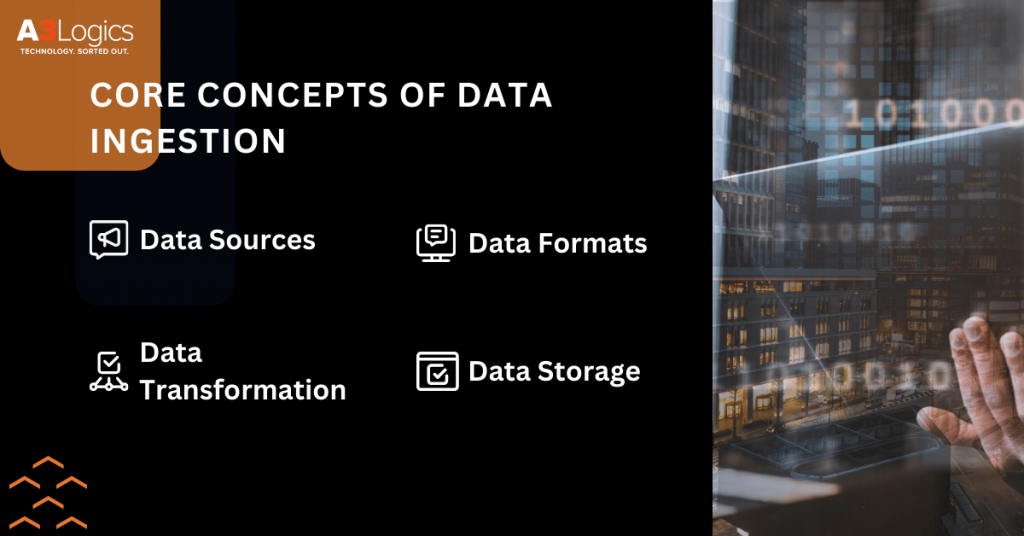
If you want to understand data ingestion, then you have to know the core concept of data ingestion. These are the four key pillars – Data Sources, Data Formats, Data Transformation, and Storage – that any strong data ingestion process would have as its base. Let’s look at the core concepts:
1. Data Sources
This is where your data comes from. Data is produced everywhere, in clouds, on some apps and websites, by sensors, by customer transactions, by messages, by social networking and beyond. They can also be internal systems, like the ones a company keeps, like its CRM or ERP, or external services, such as a weather API or some social platforms.
A good ingestion system should be able to rule out all those sources and pull data from them seamlessly.
2. Data Formats
Data always does not come in a standardized format. Some come in spreadsheets and CSV, some others come in databases: SQL, and lastly, others come in web formats: JSON, XML, etc.
Understanding and dealing with various formats is critical as your system needs to “read” the data correctly before doing anything with it. A strong ingestion tool would be able to recognize and process as many of these formats as possible without breaking an exertion.
3. Data Transformation
Raw data is usually ‘messy’; it’s incomplete, inconsistent, or not ready for processing. Data transformation is the point where one cleans, organizes, and sometimes transforms data into a better-structured format for use: error fixing, removing duplicates, changing date formats, field merging, etc.
The transformation process ensures that the data is ready for whatever your end goal is: analysis, reporting, or machine-learning input.
4. Data Storage
After collecting and cleansing the data, it needs a place where it will live, which is your storage space for data: a data warehouse, a data lake, or a cloud-based platform.
It will matter how the data is accessed and how fast and easy access and diversions can be made for consumption later. The right storage solution should be the one that secures organized access to the business in a ready form.
Mastering data ingestion begins with understanding these four pillars. When you know your data sources (Sources) and how they are formatted (Formats), cleaned (Transformation), and stored (Storage), you have the necessary foundation for building a smart, data-driven system.
Types of Data Ingestion
Different types of data ingestion methods exist, and each one serves its purpose for different business needs, which is the reason not all data is absorbed in the same way; some absorb it all at once, and some do it bit by bit every second. Let’s look at the three approaches that are popularly known: Batch ingestion, real-time (streaming) ingestion, and hybrid ingestion.
1. Batch Ingestion
Batch ingestion is laundry for a week: you store it up, clean it, and move it.
This works for you; for example, if daily sales reports can be generated and archived data moved – it is not, therefore, necessary, and you can afford to wait.
Pros:
- Simple to set up
- Cost-effective
- Ideal for large volumes of historical data
Cons:
- Not suitable for real-time decision-making
- Delayed access to the latest data
2. Real-Time (Streaming) Ingestion
Real-time ingestion resembles live newsgathering- it feeds and processes data instantly as soon as an entity creates it. This works very well in applications like tracking purchases in real-time for online orders, detecting fraud in banking based on events, or assessing user behaviour when they visit websites or apps.
Pros:
- Instant data availability
- Great for time-sensitive decisions
- Enables real-time dashboards and alerts
Cons:
- More complex and costly to implement
- Requires more processing power and faster storage
3. Hybrid Ingestion
This combines both batch and real-time approaches to form a hybrid ingestion. For instance, immediate data is held by a retail company in real-time until a time is deemed more appropriate to the processing of sales from the end of the day with batch ingestion.
Pros:
- Flexible and scalable
- Supports both real-time and historical data
- Optimizes cost and performance
Cons:
- More complex to manage
- Needs careful planning and setup
Your selection of data ingestion depends largely on what your own purposes and means are and, indeed, how much and how fast you want your data. Batch works best for periodic updates; real-time suits instantaneous actions, and hybrid gives you the flexibility to handle both. The bottom line is finding an appropriate ingestion method to suit your business needs so that you are always having the right data at the right moment.
Top Data Ingestion Tools
With data in motion from all angles, the most appropriate tool will collect and push the data as efficiently as it is possible for making a company drive what they call “data-driven”. And such tools tend to be endless. There are so many; some have the best features, others have varied use cases, and others possess cool features. Next up is a list of the most popular ingestion of data tools, as well as what makes them stand out, followed by the key factors one should consider while choosing the right ingestion tool.
Popular Data Ingestion Tools
1. Apache NiFi
Strengths: Easy-to-use web interface, strong flow-based programming; great for real-time and batch processing
Best For: Highly flexible and visual control for a business, real-time streaming, and complex data flows
2. Apache Kafka
Strengths: Large-scale, real-time data streams; it is highly scalable and fault-tolerant
Best For: Event-driven architectures, real-time analytics, and high-volume systems that need processing of millions of events per second
3. Amazon Web Services Glue
Strengths: Fully managed, good integration with other AWS services, in-built data transformation
Best For: AWS-based cloud environments, batch processing, and ETL workflows
4. Talend
Strengths: Strong drag-and-drop interface, good range of source data, good batch and real-time capability
Best For: The enterprise looking for an all-in-one data platform with good integration and transformation capabilities
5. Google cloud dataflow
Strengths: Serverless, real-time and batch processing, integrate very smoothly other tools from within Google Cloud
Best For: Users of Google Cloud who require powerful, flexible data pipelines for large-scale processing
6. Fivetran
Strengths: Automated data connectors, minimal setup, great for syncing data to warehouses
Best For: Enterprises who are looking for a quick plug-and-play solution for syncing data from SaaS tools into data warehouses.
7. Informatica
Strengths: Enterprise-grade features, strong data governance, support for cloud, hybrid, and on-prem environments
Best For: Large enterprises with complex data requirements and compliance needs.
Factors to Consider When Choosing the Right Data Ingestion Tool
It isn’t all about going to the most popular ingestion tool, but it has marks on what is right for your business. Keeping these key things in mind will help greatly in making the right call:
> Compatibility
Confirm all data sources, formats, and destinations are supported by your tool as the system used by yours. Compatibility thus prevents that all-important data lock from occurring.
> Scalability
Is the tool able to grow with your business? An effective ingestion tool will be appropriate when it comes to growing the volume of data while maintaining its performance.
> Budget
Some tools are free and open-source, and some require licenses or subscriptions. Having said that, consider both the one-off and ongoing costs.
> Community & Support
When issues occur, such high user and official support can make a lot of difference. Look for tools that have good documentation, forums, or other customer support options.
> Ease of Use
If your team comprises non-developers, you want a tool that allows them to use drag-and-drop interfaces or low-code options.
Whether you need real-time streaming, batch updates, or somewhere in between, there is a data ingestion tool for your requirements. Tools like Kafka, NiFi, Fivetran, and Talend shine in their particular contexts. It is about weighing your needs – compatibility, scalability, budget, support, and ease of use, before settling for a tool that allows your data to flow frictionlessly.
Real-Life Use Cases of Data Ingestion Across Industries
At first glance, it appears to be a technical effort; however, data ingestion is that revolutionary force pummeling the industry’s threshold barriers. Saving lives in healthcare through optimizing routes in transportation, data has bestowed speedy actions with enhanced precision and intelligence on businesses by efficient collection and movement of data from one point to another. Some of the real-case instances that could have been data ingestion at work are:
1. Healthcare
- Electronic Health Records (EHR)
Hospitals and clinics receive patient information from different sources, such as lab results, wearable devices, and doctor visits. Ingestion of such information into a central EHR serves to provide doctors with a comprehensive and up-to-date report on that patient’s every health-related activity, as well as greater diagnoses and treatment purposes.
- Remote Patient Monitoring
Gadgets, from fitness trackers to the most advanced smart medical monitors, collect data about things like heart rates and levels of oxygen. Ingesting this data into real-time data allows healthcare providers to see their patients while getting notified about anything abnormal, which has improved outcomes and reduced the need for hospitalization.
2. Finance
- Fraud Detection
Real-time data ingestion of banks begins right at the point of transaction processing while the transactions are happening. Suspicious patterns would thereby be identified in real-time, and immediate action would be taken, e.g., freezing the accounts or sending alerts to customers to avert fraud.
- Risk Management
Data gathered from the market, customer accounts, and worldwide news feeds are then ingested by financial institutions. Fast data ingests enable real-time assessment of risks, echoing sound investment or credit decisions.
3. Manufacturing
- Supply Chain Optimization
Factories ingest data from suppliers, transportation systems, and warehouses. This real-time information allows companies to predict delays and schedule inventory and production processes to avoid disruptions.
- Predictive Maintenance
Data on temperature, vibrations and usage is transmitted via the sensors attached to machines in the factory. Real-time ingestion of this data produces early signs of degradation, allowing preemptive maintenance before a complete breakdown occurs, in addition to saving dollars and downtime.
4. Transportation
- Traffic Management
Roads across the cities are monitored using cameras, GPS devices, and traffic sensors. The ingesting of real-time data results in smart traffic lights, which give congestion alerts and provide live traffic mapping, thereby speeding up the process of urban mobility while increasing safety.
- Autonomous Vehicles
Self-driving cars are reliant on a continuous data feed from cameras, lidar, GPS, etc. By processing this data in real-time, the cars can understand their environment, decide what to do, and react very quickly to changes in the road situation.
5. Energy
- Smart Grids
Among many applications, energy distribution companies are using smart data systems to gather data on energy consumption by homes and businesses. This data is ingested and analyzed instantly to balance supply and demand, prevent outages, and promote energy conservation.
- Predictive Maintenance for Wind Turbines
Sensors mounted on wind turbines constantly monitor performance and environmental conditions. Real-time ingestion of data predicts potential failures to carry out preventive maintenance and make sure energy generation is not compromised.
Data ingestion is the invisible force behind modern innovations, from patient care to self-driving cars. It enables industries to collect, process, and act on data better and faster, changing juvenile information into a world of good. Whether it’s about saving lives or managing risks and efficacies, data ingestion is indeed making a difference.
How to Get Started with Data Ingestion Using A3Logics Data Engineering Services?
In the digital world, business decisions are only as good as their data; this is where A3Logics Data Engineering Services come in. We help businesses like yours through data ingestion processes, converting disparate data sources into a credible, real-time resource that you can rely on. Be it any stage of the life cycle of data starts or scales-up operations, our experts simplify the journey for you to comply with security and scalability.

What We Offer?
At A3Logics, our custom solutions encompass the end-to-end data ingestion processes that include everything from connecting to different sources for data to real-time processing and storage of data. The team designs a custom-made data pipeline depending on your business models, be it IoT sensors, cloud, service applications, or any legacy systems.
We work with set, real-time, or hybrid ingestion models and with the latest industry tools, namely Apache Kafka, AWS Glue, and Talend-creating solutions that are fast, flexible, and ready for the future.
Steps to Implement Data Ingestion Tools
The process starts with an easy working experience! We usually set the clients in establishing and running successful data ingestion pipelines in the following way:
1. Discovery & Assessment
It deals with understanding your current data topography, which includes what sources you are using, what formats are being handled, and what business goals are in mind.
2. Designing the Pipeline
Afterwards, the design of the data ingestion pipeline takes place according to your needs, such as selecting suitable tools, defining the best ingestion method (i.e., batch, real-time, or hybrid), and mapping out transformation rules.
3. Integration & Development
Then, we build the pipeline and integrate systems with it to keep functioning with your databases, APIs, applications, or cloud platforms.
4. Testing & Validation
Before going live, we conduct rigorous tests on the pipeline for aspects such as data accuracy, security, speed, and scalability, ensuring viability under real-world situations when launched.
5. Deployment & Monitoring
Once all is said and done, we deploy the solution, providing continuous monitoring and support to ensure a smooth and secure flow of data.
Benefits for Clients
When you partner with A3Logics, you will not only implement data ingestion but also create a pathway to success for your business. Benefits you can expect include the following:
- Accelerated Decision-Making Real-time access to data on-the-fly
- Improved Data Quality Automate cleaning and transformation
- Scalable Adaptability for your data and business
- Safe and Compliant Protecting any sensitive information flowing through our pipelines
- Reduced Costs Optimizing resources and minimizing manual efforts
- Experienced Support Dedicated support from our Data Engineering professionals
There is nothing complex about getting started with data ingestion. A3Logics data analytics services, however, provides you with a partner that you can rely on to set up and scale. Come, let us transform your raw data into real business. Are you ready? Let us build your data future together.
Nutshell
In this data-led, fast-moving world, having a good amount of data at the right time proves to be everything. Data ingestion is the very first and most vital way to make this happen. It lets you pull data from various portals, clean data, and prepare it for smarter-informed actions that are quicker and results all the better.
As per the current scenario, from healthcare to finance and manufacturing to transportation, every industry employs data ingestion to stay ahead of the game. And with appropriate tools and the right partner like A3Logics, getting started isn’t that hard.
Whether you need real-time insights improvement, operational efficiency enhancement, or future growth planning, data ingestion strategy will guide you. The first step here is converting data into the biggest business advantage you can obtain.



